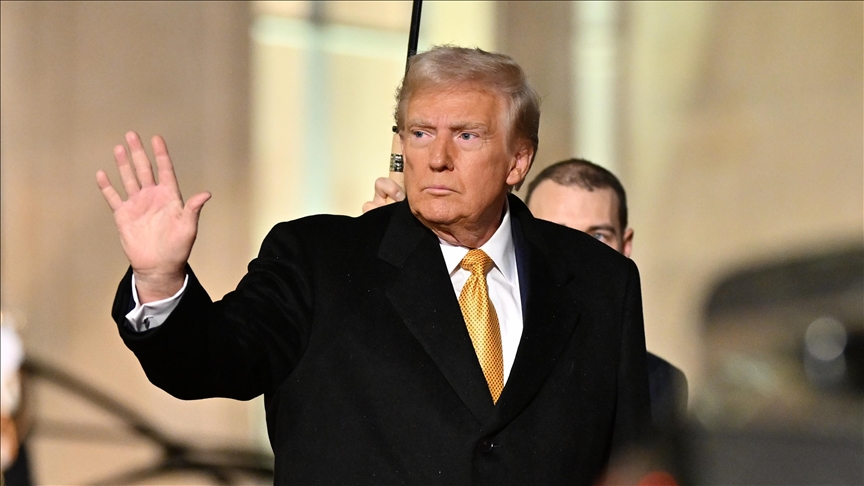Return of ‘Trumponomics’: What to expect for US and the world
Analysts remain skeptical over incoming US president's economic plans centered around tax cuts and tariffs

- 'Most economists don't favor the idea of tariffs in general. They see them as inflationary,' says Chatham House's Leslie Vinjamuri
- 'Blanket across-the-board tariffs will ultimately lead to unequivocal rising prices on consumers,' says Joe Hughes of the Institute on Taxation and Economic Policy
ISTANBUL
During his election campaign, US President-elect Donald Trump focused extensively on domestic and international economic concerns as one of his key items, which ended up with him and the Republican Party winning the election.
Trump’s economic policies were controversial in his first term from 2016-2020. His actions, such as pulling out from the Trans-Pacific Partnership and Paris agreements, along with increasing tariffs with China, received backlash due to their “isolationist” attitude.
Domestically, Trump introduced the Tax Cuts and Jobs Act in 2017, which was a major overhaul of the US tax code aimed at reducing tax rates for individuals and businesses while reducing the need for detailed record-keeping, calculation of certain deductions and navigating complex rules, making filing taxes easier for many Americans.
In essence, the initiative aimed to stimulate economic growth through tax cuts, but it also significantly increased the federal deficit and shifted tax benefits more toward businesses and higher-income individuals.
Joe Hughes, senior policy analyst at the Institute on Taxation and Economic Policy, described the stimulatory effect of the Trump tax cuts as “unclear.”
“It's unclear even how much they did boost domestic investment. The initial estimates we saw before the bill had passed…We never saw that sort of shift in investment afterwards,” he said.
Leslie Vinjamuri, director of the US and the Americas Program at Chatham House, said some of Trump’s taxation ideas, such as exempting tax on tips, is very important for a significant number of Americans working in the service industry, even though it would be detrimental to the federal budget deficit.
“He's talked about things like cutting taxes on tips...in a country where tipping culture is high...The promise to lift taxes on those tips was a very important pledge that he made during his campaign, but it will contribute to a deficit,” she said.
Hughes also suggested that besides the stimulatory effect of the Trump tax cuts, their contribution to growth is negligible, as most of the growth occurs from inflation.
“And most of the growth -- this came from the Congressional Budget Office last week -- most of the growth in revenue that we've seen since 2017 is due to inflation...goods costing more, people making more money and then paying more taxes,” he said.
Considering that the US Federal Reserve cut its key interest rate by 0.25% earlier this month, Vinjamuri said this decision by the Fed signals the expectation that inflation might rise as a consequence of the expected shock the system will take because of tax cuts and tariffs that will end up fueling the deficit.
“You can't have across-the-board tax cuts, increasing those tax cuts, reducing the debt, and delivering a healthy and robust economy with tariffs, and getting rid of immigrants who are critical to working many of the jobs that need to be filled so that wages don't go up. If wages go up, inflation goes up. So we know the story,” she said.
‘Office of Department of Government Efficiency is fundamentally unserious’
One of the most pressing concerns that has haunted the US bureaucracy is the ever-increasing budget deficit.
Currently, US public debt is in excess of $36 trillion, as the federal budget in the 2024 fiscal year ran a deficit of $1.8 trillion despite revenues reaching $5 trillion.
The Department of Government Efficiency, also known as DOGE, is projected to be headed by tech billionaire Elon Musk and fellow business titan Vivek Ramaswamy and was announced by Trump to “go forward with this idea to slash excess regulations, cut wasteful expenditures and restructure Federal Agencies.”
While very controversial figures have been cited by Ramaswamy and Musk, such as firing 75% of federal employees and slashing $2 trillion on the budget, Hughes does not believe these are possible without congressional approval and going through standard procedure.
“It's a very performative role that he has given to people who like to be in the media and who were staunch supporters of Trump on the campaign trail," he said.
"The reality is...if there are changes that you want to make to the budget, then there's a long existing process for doing that, which is that you come out with your budget...and you submit that to Congress,” Hughes said.
Even if DOGE could manage to get congressional approval, the cuts would primarily be focused on areas of the budget that could gain wide disapproval from the public, according to Hughes.
“Nearly 60% of the federal budget is three things -- Social Security, Medicare and defense. Another 10% of that goes to interest payments on the debt.”
“Basic math tells you that if you're not going to cut Social Security, Medicare or defense and you're also going to add to the deficit through tax cuts that are geared toward the wealthy, then you'll have to cut almost every remaining program by some large amount. I think this office of the Department of Government Efficiency is fundamentally unserious,” he noted.
Citing Musk’s recent posts on X, Hughes said some of the programs being targeted for cuts are in the range of millions of dollars, a very insignificant portion of the multi-trillion federal budget.
“If you're working with the federal budget, which is in the trillions of dollars, then that's not even 1%. That's not even 0.1% of the federal budget. So you're not getting anywhere by cutting millions of dollars at a time, which is why I was saying if you seriously want to cut the debt, then you either have to increase taxes on the wealthy rather than cutting them or you have to cut Social Security, Medicare and defense.”
Economic realities of a tariff regime
Since his first presidency, Trump’s usage of tariffs has been very prolific. Tariffs were also featured extensively in his second presidential campaign and are expected to be a centerpiece of his plans.
“It does seem that a consistent theme of his campaign, and now during the transition, is to replace broad parts of the income tax code with tariffs on imported goods. The bottom line of that is that it will raise taxes on middle-income families and it still won't be enough to pay for the tax cuts that go to the ultrawealthy,” Hughes noted.
A key idea behind tariffs and tax cuts is to promote manufacturing within the US. The extent that these changes could achieve the desired effect is dubious, according to Hughes, who believes that tariffs are only going to result in higher costs for consumers.
“There may be some shift back to manufacturing within the US, and that can certainly be a good thing when we're talking about critical industries like steel or pharmaceuticals. It can be a good thing when we're talking about industries where maybe there have been uncompetitive trade practices in China or elsewhere," he said.
"But blanket across-the-board tariffs will ultimately lead to unequivocal rising prices on consumers.”
According to Vinjamuri, Trump’s idea that tariffs could make up for the revenue loss by the tax cuts is “outright rejected” by economists.
“Most economists also don't favor the idea of tariffs in general. They see them as inflationary,” she said.
Anadolu Agency website contains only a portion of the news stories offered to subscribers in the AA News Broadcasting System (HAS), and in summarized form. Please contact us for subscription options.







